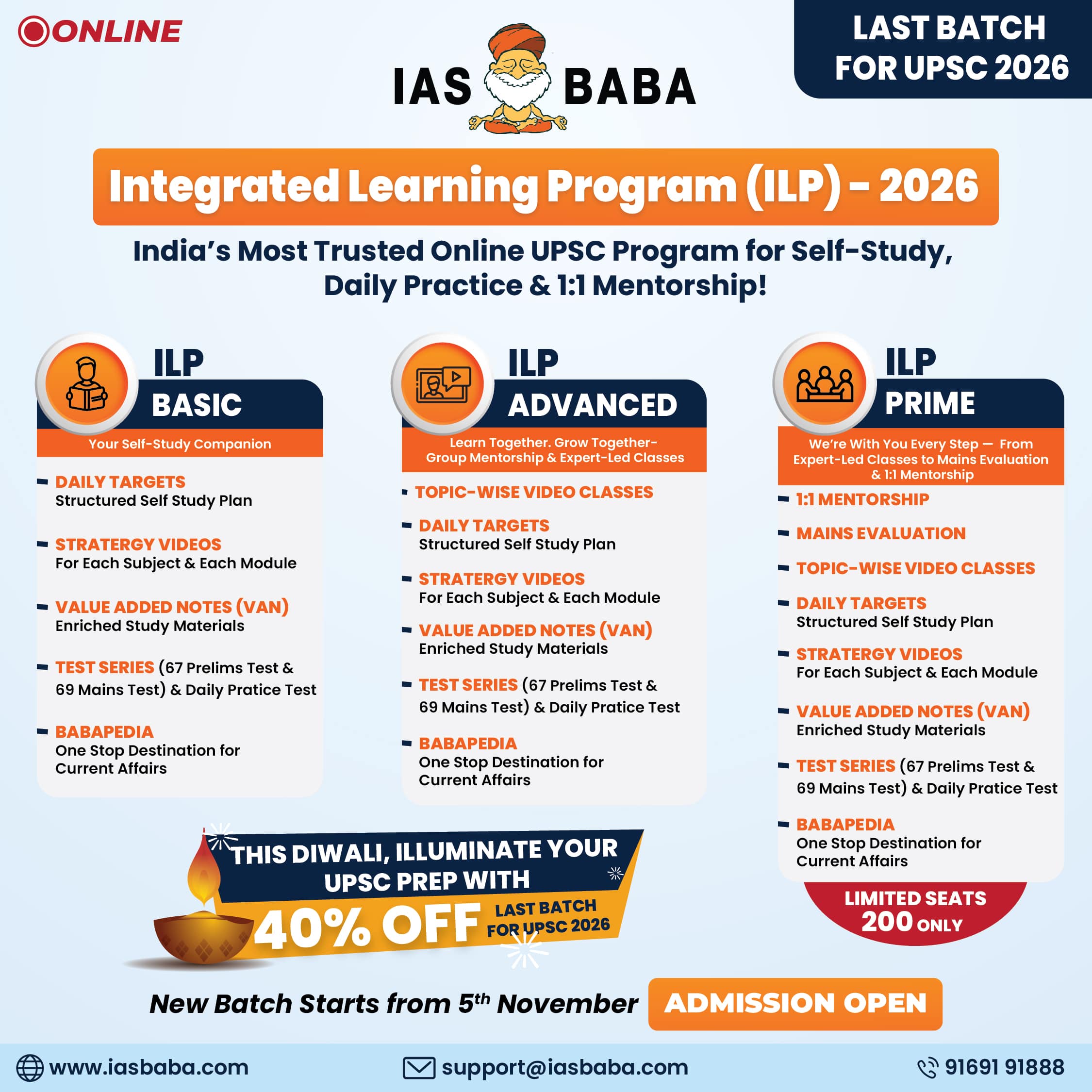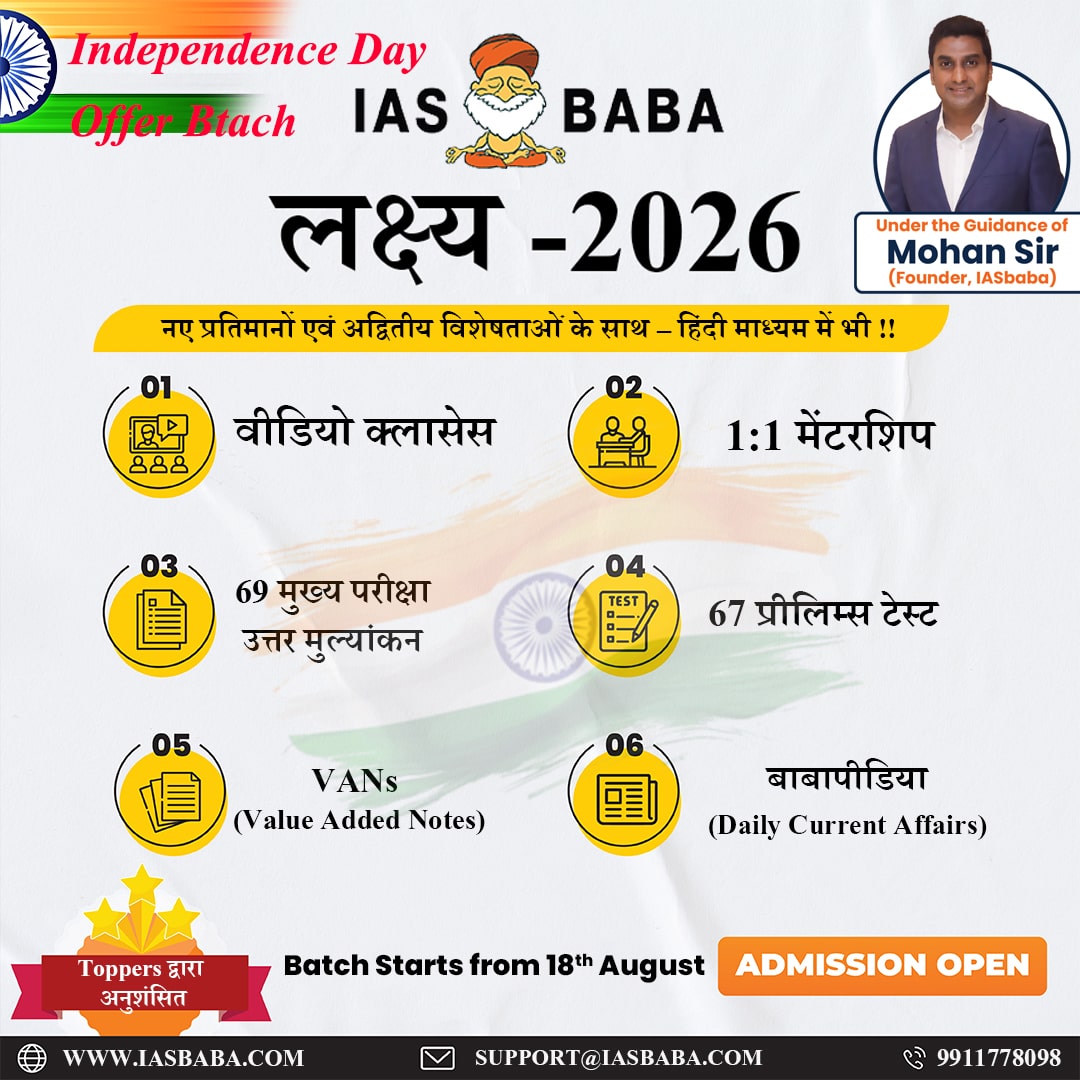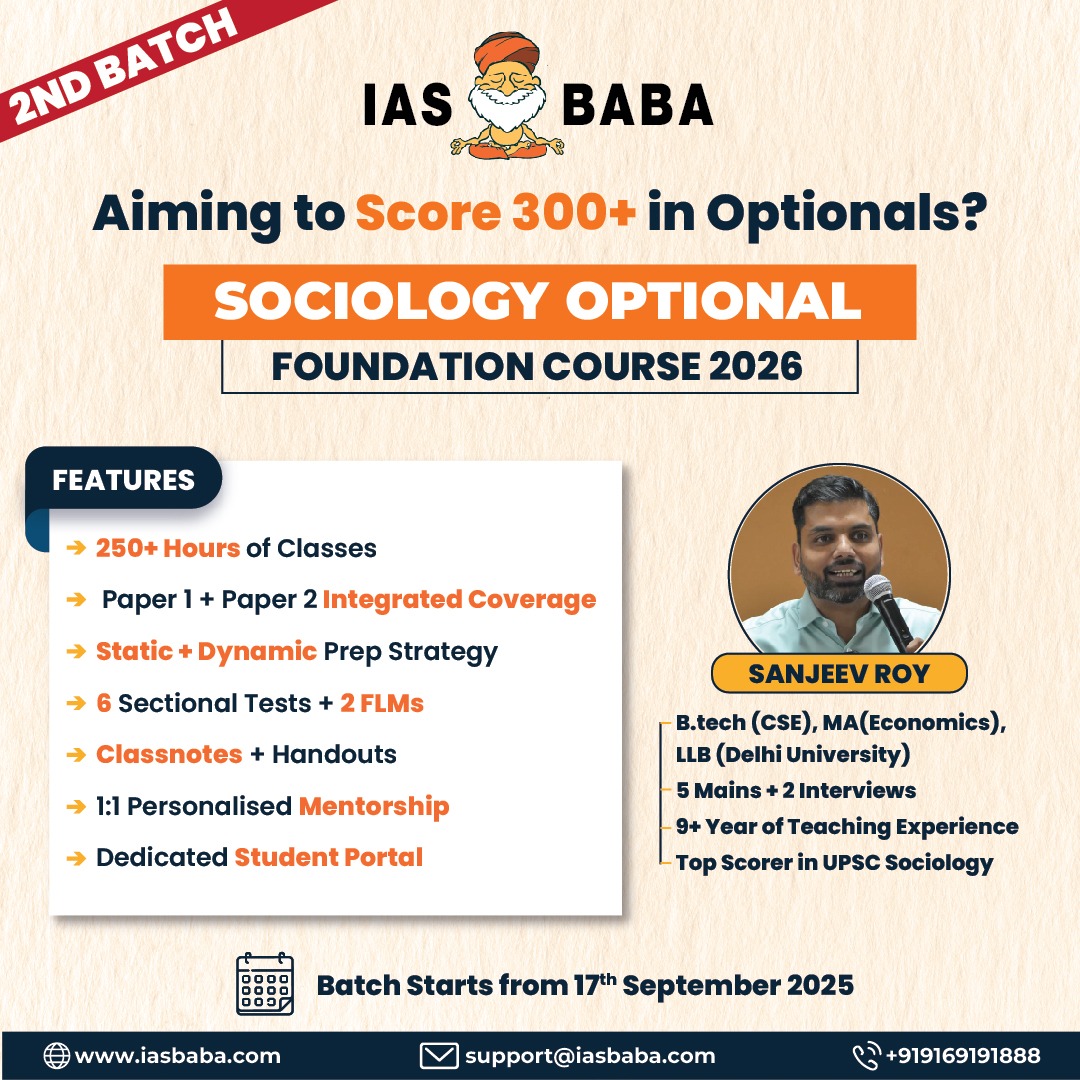IASbaba's Daily Current Affairs Analysis
Archives
(PRELIMS Focus)
Category: INTERNATIONAL
Context: Prime Minister Narendra Modi’s two-day visit to Cyprus marks a significant step in revitalizing India-Cyprus relations after more than two decades
Decoding Context:
The visit aimed to deepen cooperation in trade, investment, technology, and security.
Key Highlights
- Diplomatic Talks: PM Modi met with President Nikos Christodoulides to enhance bilateral cooperation across strategic sectors.
- Business Roundtable: Business leaders from both nations convened in Limassol, leading to proposals for long-term economic collaboration.
- Strategic Timing: The visit gains importance with Cyprus set to hold the EU Council presidency in 2026 and amid shifting regional alignments involving Turkey and Pakistan.
Focus Areas of Cooperation
| Area | Cooperation Focus |
|---|---|
| Trade & Investment | Boosting trade, increasing FDI, using Cyprus as a gateway to Europe |
| Technology | Collaborating on innovation and tech-driven sectors |
| Security | Tackling cross-border terrorism and enhancing regional security ties |
| International Support | Cyprus backs India on global issues like Kashmir and UN reforms |
Geopolitical Significance
Cyprus, being part of the EU and Commonwealth, holds strategic importance for India’s outreach to Europe. The partnership also supports India’s goals related to the India-Middle East-Europe Economic Corridor (IMEC), leveraging Cyprus’s maritime location.
Leadership Remarks
PM Modi hailed Cyprus as a close friend and valued partner in the Mediterranean and EU. Both nations reaffirmed commitment to concluding the India-EU Free Trade Agreement.
Conclusion
The visit signals a new phase of strategic, economic, and diplomatic collaboration, setting the stage for deeper and sustained engagement between India and Cyprus.
Learning Corner:
Note on India–Cyprus Relations
India and Cyprus share a historically warm and mutually supportive relationship, rooted in shared values of democracy, non-alignment, and multilateral cooperation.
Key Aspects of the Relationship:
- Diplomatic Ties: Established in 1962, the two countries have maintained consistent engagement through high-level visits, bilateral agreements, and participation in international forums.
- Economic Cooperation:
- Cyprus is a significant source of Foreign Direct Investment (FDI) into India, especially in sectors like real estate, finance, and services.
- Recent focus on enhancing collaboration in technology, pharmaceuticals, and green energy.
- Support on International Issues:
- Cyprus has consistently supported India’s position on Jammu & Kashmir and its bid for a permanent seat in the UN Security Council.
- India, in return, has supported Cyprus’s territorial integrity and sovereignty, especially in the context of its dispute with Turkey.
- Cultural and Educational Exchanges:
- Programs under ICCR scholarships and growing interest in yoga and Ayurveda have boosted people-to-people ties.
- Strategic Importance:
- Cyprus’s EU membership and geostrategic location make it an important gateway for India into Europe and the Mediterranean region.
- Cooperation expected to grow in light of the India-Middle East-Europe Economic Corridor (IMEC).
Source : THE HINDU
Category: SCIENCE AND TECHNOLOGY
Context: India is emerging as a key player in integrating artificial intelligence (AI) into biotechnology and biomanufacturing.
Decoding Context:
Initiatives like the BioE3 Policy and IndiaAI Mission aim to make India a global leader in ethical, AI-driven bio-industrial innovation. However, regulatory gaps and fragmented policies pose significant challenges.
Key Highlights
AI’s Role in Biomanufacturing
- AI is enhancing drug screening, optimizing production, and improving quality control.
- Firms such as Biocon and Strand Life Sciences are using AI for drug discovery, diagnostics, and personalized medicine, reducing costs and speeding up innovation.
Regulatory and Policy Challenges
- Current policies lack clarity on data standards, ownership, and licensing.
- Reliable, representative AI models are essential, especially in sensitive sectors like healthcare.
- Without streamlined regulation, innovation may be hindered or face legal complications.
Need for Data Diversity and Risk-Based Regulation
- AI systems must be trained on diverse datasets to ensure safety and relevance to India’s varied conditions.
- There’s a call for adaptive, context-aware regulations similar to global best practices.
Future Opportunities
- AI can significantly accelerate drug development by screening compounds digitally and refining manufacturing.
- India must develop clear data standards and supportive frameworks to stay globally competitive.
Conclusion
India’s success in AI-driven biomanufacturing hinges on building robust, harmonized policies that promote innovation while ensuring safety, public trust, and high data quality.
Learning Corner:
Note on Biomanufacturing
Biomanufacturing is the use of biological systems—such as microorganisms, cell cultures, or enzymes—to produce commercially important products. It lies at the intersection of biology, engineering, and industrial manufacturing.
Key Features:
- Involves living cells or their components (e.g., enzymes) to manufacture biopharmaceuticals, vaccines, biofuels, enzymes, and biomaterials.
- Uses fermentation, cell culture, and synthetic biology techniques for production.
Applications:
- Healthcare: Production of therapeutic proteins, monoclonal antibodies, and vaccines.
- Agriculture: Biofertilizers and biopesticides.
- Energy: Bioethanol and biodiesel production.
- Industrial Use: Bioplastics, biodegradable materials, and enzymes for food and textile industries.
Advantages:
- Environmentally friendly and sustainable.
- Enables precision manufacturing at the molecular level.
- Reduces dependency on fossil fuels and chemicals.
Emerging Trends:
- Integration of Artificial Intelligence (AI) for process optimization.
- Adoption of continuous manufacturing over traditional batch processes.
- Growing emphasis on green biomanufacturing for climate goals.
Biomanufacturing is central to the bioeconomy and is being prioritized in national policies for healthcare innovation, sustainability, and industrial competitiveness.
Note on BioE3 Policy
The BioE3 Policy is a national-level initiative by the Government of India aimed at promoting biomanufacturing through a framework based on Economy, Environment, and Employment—the three E’s.
Key Objectives:
- Economy: Boost India’s bioeconomy by encouraging bio-based industries and reducing dependency on petrochemicals.
- Environment: Promote green biomanufacturing to reduce carbon footprint and environmental degradation.
- Employment: Generate high-skilled jobs in biotechnology, research, and industrial biomanufacturing sectors.
Salient Features:
- Supports startups, R&D, and bio-industrial parks for sustainable production.
- Encourages the development and use of bio-based alternatives to plastics, fuels, and chemicals.
- Aligns with Make in India and Atmanirbhar Bharat (self-reliant India) initiatives.
- Emphasizes circular economy principles—waste minimization, reuse, and recycling using biological processes.
Significance:
- Positions India as a global hub for sustainable biomanufacturing.
- Supports India’s climate goals under SDGs and Paris Agreement.
- Enables integration of AI and digital technologies in bio-industrial systems.
The BioE3 Policy is a transformative step towards building a resilient, green, and innovation-driven bioeconomy in India.
Source: THE HINDU
Category: SCIENCE AND TECHNOLOGY
Context : Committee of experts, chaired by Principal Scientific Advisor (PSA) Ajay Sood, has recommended that India do away with a decade-long policy of mandating Flue Gas Desulphurization (FGD) units in all coal-fired thermal power plants (TPPs).
What is an FGD Unit?
Flue Gas Desulphurisation (FGD) units are systems installed in power plants to remove sulphur dioxide (SO₂) from flue gases produced by burning fossil fuels. SO₂ is a harmful pollutant linked to respiratory problems and environmental damage.
Types of FGD Systems:
- Dry Sorbent Injection: Uses powdered sorbents like limestone to neutralize SO₂.
- Wet Limestone Treatment: Uses a slurry of limestone to scrub SO₂.
- Seawater Treatment: Utilizes alkaline seawater to absorb and neutralize SO₂.
Importance
FGDs reduce air pollution from coal-fired power plants, helping meet environmental standards and protect public health.
Costs and Challenges
- Installation costs approx. ₹1.2 crore per megawatt, making it a major investment.
- India’s coal-based capacity remains high, posing financial and logistical challenges.
- Government is reconsidering mandatory installation due to cost and feasibility concerns.
Alternatives
- Reducing coal dependence
- Switching to cleaner energy sources
- Enhancing plant efficiency
Key Takeaways
| Aspect | Details |
|---|---|
| Target Pollutant | Sulphur dioxide (SO₂) |
| Health Impact | Respiratory illness, acid rain, climate impact |
| FGD Types | Dry injection, wet limestone, seawater scrubbing |
| Installation Cost | ₹1.2 crore per MW |
| Policy Concern | High cost vs. health/environmental benefits |
Learning Corner:
Techniques to Reduce Pollutants in Thermal Power Plants
Thermal power plants emit several types of pollutants—sulphur dioxide (SO₂), nitrogen oxides (NOₓ), particulate matter (PM), carbon dioxide (CO₂), and fly ash. Various pollution control technologies are used to minimize their environmental impact:
| Pollutant | Control Technology |
|---|---|
| Sulphur Dioxide (SO₂) | Flue Gas Desulphurization (FGD) units (e.g., wet limestone method, dry sorbent injection) |
| Nitrogen Oxides (NOₓ) | Selective Catalytic Reduction (SCR) 🔹 Selective Non-Catalytic Reduction (SNCR) |
| Particulate Matter (PM) | Electrostatic Precipitators (ESP) 🔹 Baghouse Filters 🔹 Cyclone Separators |
| Carbon Dioxide (CO₂) | Carbon Capture and Storage (CCS) (still emerging) 🔹 Use of supercritical/ultra-supercritical technologies |
| Fly Ash | Dry and wet ash handling systems 🔹 Utilization in cement, bricks, and road construction |
Supporting Measures:
- Low NOₓ burners to limit NOₓ formation during combustion
- Fuel washing/blending to reduce ash and sulphur content
- Regular maintenance to ensure efficiency of pollution control equipment
- Afforestation and green belts around plant sites
Source : THE HINDU
Category: POLITY
Context : The Finance Ministry has capped spending under the MGNREGS at 60% of the annual allocation for the first half of FY 2025-26, marking a departure from the previous demand-driven approach.
Decoding Context
Government’s Justification
- Prevent rapid fund exhaustion, which has historically occurred by mid-year.
- Improve fiscal management and ensure funds last through the entire year.
Concerns Raised
- Seasonal & Emergency Needs: MGNREGS demand is not uniform and rises during crises like droughts or rural distress. The cap limits flexibility.
- Legal Validity: MGNREGS is a statutory right, and courts have held that financial constraints cannot override this entitlement.
- Payment Delays: The cap may lead to denied work or wage delays, undermining the scheme’s core objective.
The cap reflects budgetary caution but risks weakening a vital rural employment lifeline and violating legal guarantees.
Learning Corner:
Note on MGNREGA (Mahatma Gandhi National Rural Employment Guarantee Act)
The Mahatma Gandhi National Rural Employment Guarantee Act (MGNREGA), enacted in 2005, is a social security and public works programme aimed at providing livelihood security in rural India.
Key Features:
- Legal Right to Work: Provides a statutory guarantee of 100 days of wage employment per financial year to every rural household whose adult members volunteer for unskilled manual work.
- Demand-Driven Scheme: Employment must be provided within 15 days of demand, failing which unemployment allowance is payable.
- Transparency & Accountability: Includes provisions like social audits, electronic muster rolls, and direct benefit transfer (DBT) to workers’ accounts.
- Focus on Sustainable Assets: Encourages water conservation, afforestation, irrigation, and rural infrastructure development.
- Women Participation: At least one-third of beneficiaries must be women.
Importance:
- Acts as a safety net during agrarian distress or economic downturns.
- Promotes inclusive growth and poverty alleviation in rural areas.
- Supports decentralized planning via involvement of Gram Panchayats.
Source: THE INDIAN EXPRESS
Category: SCIENCE AND TECHNOLOGY
Context : In the aftermath of the Air India Boeing 787 crash in Ahmedabad, authorities are using DNA analysis to identify victims’ remains
Decoding Context:
DNA, unique to every individual (except identical twins), is collected from human remains and matched with samples from relatives.
Sample Collection & Storage
- DNA degrades after death; it survives better in cold, dry environments.
- Samples must be collected early, kept cool or frozen, and stored in ethanol.
- Bone and tooth tissues preserve DNA longer than soft tissues.
Reference Samples
- Samples from biological relatives (parents, children) are used for comparison since they share 50% of DNA with the victim.
Methods of DNA Analysis
- Short Tandem Repeat (STR) Analysis:
- Evaluates repeating DNA sequences; highly accurate for identification.
- Uses nuclear DNA; degraded DNA limits its effectiveness.
- Mitochondrial DNA (mtDNA) Analysis:
- Used when nuclear DNA is degraded.
- Passed only from mother to children, useful for tracing maternal lineage.
- Y Chromosome Analysis:
- Targets male-specific Y chromosome.
- Matches paternal male relatives (father, brother, son).
- Single Nucleotide Polymorphisms (SNPs) Analysis:
- Used when DNA is highly degraded.
- Compares specific base differences; less accurate than STRs.
Conclusion
DNA analysis, through multiple methods, plays a crucial role in identifying victims of fatal accidents when visual identification is impossible.
Learning Corner:
Important DNA Terminologies
- DNA (Deoxyribonucleic Acid)
- The hereditary material in almost all living organisms.
- Composed of two strands forming a double helix, made up of nucleotides.
- Nucleotide
- Basic structural unit of DNA, consisting of a phosphate group, deoxyribose sugar, and nitrogenous base (Adenine, Thymine, Cytosine, Guanine).
- Gene
- A segment of DNA that codes for a specific protein.
- Functional unit of heredity.
- Genome
- The complete set of DNA, including all genes, in an organism.
- Human genome has ~3 billion base pairs.
- Microsatellite DNA / Short Tandem Repeats (STRs)
- Repetitive DNA sequences, highly variable among individuals.
- Used in forensics, biodiversity studies, and evolutionary biology.
- DNA Barcoding
- Technique using a short genetic sequence from a standardized region to identify species.
- Used in wildlife protection, food authentication, and taxonomy.
- Transcriptome
- The full range of messenger RNA (mRNA) molecules expressed by an organism or cell at a given time.
- Helps understand gene expression patterns.
- DNA Sequencing
- The process of determining the exact order of nucleotides in a DNA molecule.
- Useful in genomics, disease research, and biotechnology.
- DNA Profiling / Fingerprinting
- Technique to identify individuals using unique patterns in their DNA.
- Used in criminal investigations, paternity tests, and disaster victim identification.
- Polymerase Chain Reaction (PCR)
- A method to amplify specific DNA sequences.
- Essential for medical diagnostics, genetic research, and forensic analysis.
- Gel Electrophoresis
- A method for separation and analysis of DNA fragments based on their size.
Source: THE INDIAN EXPRESS
(MAINS Focus)
Introduction (Context)
The 19th edition of the Global Gender Gap Report 2025 was published by the World Economic Forum (WEF) with the global gender gap at 68.8 per cent for 148 countries, marking the strongest annual advancement since the COVID-19 pandemic. The Global Gender Gap Index annually benchmarks the current state and evolution of gender parity across four key dimensions: Economic Participation and Opportunity, Educational Attainment, Health and Survival, and Political Empowerment.
India has ranked 131 out of 148 countries, slipping two places from its position last year.
What is the Global Gender Gap Index?
The Global Gender Gap Index is an annual benchmarking tool published by the World Economic Forum (WEF) to assess gender-based disparities across countries. First introduced in 2006, it evaluates gender parity across four critical dimensions:
- Economic Participation and Opportunity: This dimension assesses the extent to which men and women have equal access to job opportunities, income, and leadership roles in the economy.
Data considered:
- Labour force participation rate (men vs women)
- Wage equality for similar work
- Estimated earned income
- Ratio of women to men in senior positions and technical jobs
2. Educational Attainment: This measures the gap in access to basic and higher education between genders.
Data considered:
- Literacy rate (male vs female)
- Enrollment in primary, secondary, and tertiary education (girls vs boys)
3. Health and Survival: This dimension evaluates gender differences in life expectancy and biological survival.
Data considered:
- Sex ratio at birth (to assess issues like son preference or female foeticide)
- Healthy life expectancy (how long women and men live in good health)
4. Political Empowerment: This assesses the gap in political representation and leadership roles between men and women.
Data considered:
- Percentage of women in national parliaments
- Percentage of women in ministerial roles
- Years with a female head of state (over the past 50 years)
The Index scores range from 0 to 1, where 1 indicates full gender parity and 0 denotes absolute disparity. A higher score thus implies a smaller gender gap.
Highlights of the Global Gender Gap Report 2025
- Global gender parity stands at 68.8%, the highest annual increase since the COVID-19 pandemic.
- Iceland ranks 1st for the 16th consecutive year with 92.6% parity, followed by Finland, Norway, UK, and New Zealand.
- Bangladesh is the top performer in South Asia, ranked 24th globally, jumping 75 positions from last year.
- Among the 148 economies covered in the 2025 index, the Health and Survival gender gap has closed by 96.2%, the Educational Attainment gap by 95.1%, the Economic Participation and Opportunity gap by 61.0%, and the Political Empowerment gap by 22.9%.
- Women represent 41.2 per cent of the global workforce, but a stark gap persists with women only holding 28.8 per cent of top leadership positions.
- Nepal ranked 125, Sri Lanka 130, Bhutan 119, Maldives 138 and Pakistan 148.
Significance of the Index for Policymakers
- Acts as a policy diagnostic tool for gender equality.
- Helps track progress over time and prioritize areas requiring urgent intervention.
- Supports the design of gender-responsive policies in education, health, employment, and governance.
- Encourages benchmarking with global best practices.
India’s Performance
- India ranks 131 out of 148 countries, slipping two places from 2024.
- Parity score: 64.1%, among the lowest in South Asia.
- India’s overall score improved slightly (+0.3 points), but the decline in political empowerment negated gains.
Why India Performs Poorly?
- Low female labour force participation (45.9%) and limited access to leadership roles.
- Income disparity persists: women earn only 29.9% of male income.
- Parliamentary representation dropped to 13.8%, with ministerial roles down to 5.6%.
- Social norms, patriarchy, and policy inertia restrict opportunities.
- Delay in implementation of reforms like the Women’s Reservation Act till 2029.
Value Addition
- Gender Inequality Index (GII): GII is published by the United Nations Development Programme (UNDP) in their Human Development Report. It measures gender inequalities in three key dimensions — reproductive health, empowerment, and labour market. The score ranges from 0, where women and men fare equally, to 1, where one gender fares as poorly as possible in all measured dimensions. India has a GII value of 0.403, ranking it 102 out of 172 countries in 2023.
- Gender Development Index (GDI): It is published by UNDP. GDI measures gender inequalities in achievement in three basic dimensions of human development: health, education, and command over economic resources, measured by female and male estimated earned income. According to the Human Development Report 2025, the 2023 female HDI value for India is 0.631 in contrast with 0.722 for males, resulting in a GDI value of 0.874.
- Global Gender Parity Index (GGPI): It is a composite scheme developed by UNDP and UN Women to assess the status of women’s achievements relative to men’s in four dimensions of human development: life and good health; education, skill-building and knowledge; labour and financial inclusion; and participation in decision-making.
- Women’s Empowerment Index (WEI): It is a composite index developed by UNDP and UN Women to measure the level of women’s empowerment across five dimensions: health, education, inclusion, decision-making, and violence against women. A value close to 1 indicates higher empowerment across the five dimensions, and a value close to 0 indicates lower empowerment. India’s score is 0.52.
Way Forward
- Implement Women’s Reservation Act proactively even before 2029.
- Invest in women-centric skill development and entrepreneurship.
- Ensure gender-sensitive budgeting and enforce equal pay laws.
- Increase representation of women in political parties and decision-making bodies.
- Address structural patriarchy and safety concerns through education and awareness.
- Improve access to digital literacy, financial services, and healthcare for women.
Conclusion
India’s slight improvement in the Global Gender Gap Index is overshadowed by its decline in political empowerment and its poor ranking overall. While policies are in place, the implementation lag and socio-cultural barriers limit their effectiveness. The passing of the Women’s Reservation Bill is symbolic of India’s intention but delaying its enforcement sends mixed signals. The true benchmark for success is not just improving rankings, but achieving real, inclusive, and equitable gender parity on the ground.
Mains Practice Question
Q In light of the Global Gender Gap Report 2025, analyze the structural and institutional barriers to gender parity in India. (250 words, 15 marks)
Introduction (Context)
The Union Finance Ministry has recently imposed a spending cap on the Mahatma Gandhi National Rural Employment Guarantee Scheme (MGNREGS) for the first half of FY 2025–26. According to this decision, only 60% of the total budget allocation can be used until September. This marks a significant shift in the operational structure of the scheme, which has traditionally been demand-driven and exempt from budgetary caps. Now it has been brought under the Monthly Expenditure Plan/Quarterly Expenditure Plan (MEP/QEP).
About MGNREGA
The Mahatma Gandhi National Rural Employment Guarantee Act (2005) is a landmark legislation aimed at providing a legal guarantee of wage employment to every rural household.
Key Features:
- MGNREGA provides a legal right to wage employment for rural households, ensuring a minimum of 100 days of work per year.
- The scheme targets rural households, particularly those in need of wage employment and willing to do unskilled manual work.
- Rural households can apply for registration with the Gram Panchayat, which then issues job cards after verification.
- Wages are to be paid according to the state’s minimum wage rate, and there’s a provision for equal payment for men and women. Wages are to be paid within a fortnight.
- Work is to be provided within a 5-kilometer radius of the applicant’s residence if possible, and within the block if not. If work is provided beyond 5 kilometers, travel allowances are provided.
- MGNREGA prioritizes the participation of women in the workforce, aiming for at least one-third of beneficiaries to be women.
- The scheme promotes transparency and accountability through social audits of all works and expenditures conducted by the Gram Sabha.
- MGNREGA aims to strengthen the role of Panchayati Raj Institutions in planning and implementing the scheme, promoting a bottom-up approach to development.
- The scheme promotes sustainable development by prioritizing works that contribute to ecological conservation and rural infrastructure development such as Water conservation, drought proofing, afforestation, irrigation canals, and rural infrastructure.
- MGNREGA specifically targets vulnerable sections of rural areas, including Scheduled Castes, Scheduled Tribes, women-headed households, and other marginalized groups, aiming to strengthen their livelihood resource base.
Significance of the Scheme
- MGNREGA provides a vital source of income for rural households, particularly during lean agricultural seasons, and for those who have limited access to other employment opportunities.
- The program promotes the development of rural infrastructure, including irrigation systems, roads, and community buildings, which benefits the entire community.
- MGNREGA ensures a legal right to work, a critical step in addressing poverty and inequality in India.
- Women are actively encouraged to participate in MGNREGA, and the program provides them with an opportunity to earn income and improve their social standing.
- The program is demand-driven, meaning that employment is provided based on the number of individuals seeking work, ensuring that resources are channeled to those who need them most.
- By providing a guaranteed income, MGNREGA helps reduce poverty and improves the overall quality of life in rural areas.
- The program also offers an unemployment allowance to those who are unable to find work within 15 days of applying, providing a safety net for those in need.
- MGNREGA promotes social mobilization and participation by empowering communities to take ownership of development initiatives.
Achievements So Far
- Provided employment to 6–7 crore rural households annually.
- Boosted financial inclusion through Aadhaar-linked DBT systems.
- Helped meet multiple Sustainable Development Goals (SDGs) like poverty eradication, gender equality, and decent work.
- Played a pivotal role in climate resilience and eco-restoration in rural India.
Why government has placed cap?
MGNREGS has long been plagued with financial troubles, which are perhaps what the Finance Ministry hopes to address by implementing the MEP/QEP mechanisms.
- In past years, over 70% of the MGNREGS budget is usually spent by September. By December, the government often has to give extra (supplementary) funds, but these also run out by January.
- Every year, the government ends up with unpaid bills (pending dues). In the last 5 years, these pending dues have ranged from ₹15,000 crore to ₹25,000 crore.
- On average, 20% of the new year’s budget is used just to pay for last year’s unpaid work. This delays fresh payments and new works.
- To avoid mid-year shortages and unpaid dues, the Ministry has now limited spending to 60% of the total budget for the first half (April–September).
- This is being done under the Monthly/Quarterly Expenditure Plan (MEP/QEP) system, which controls spending pace.
Data:
- The MGNREGS budget for FY 26 stands at Rs 86,000 crore, and FY 25 ended with pending dues of Rs 21,000 crore.
- As on June 12, the Centre has released 28% of FY 25-26’s budget. Pending dues for FY 26 stand at Rs. 3,262 crore, and for FY 25 at Rs 19,200 crore. Just clearing these dues will exhaust approximately 50% of the budget.
- By implementing an expenditure cap, the Finance Ministry is likely ensuring an adequate budget will remain for the latter half of the FY, so that no supplementary allocation will have to be made.
Disadvantages of placing the cap
Issue of fluctuating demand
- MGNREGA is designed to respond to rural employment demand, which fluctuates with agricultural and climatic cycles. For example, in 2023, low rainfall led to 20% higher work demand in July and August. In Karnataka, extreme drought led to spending of over 70% of the annual MGNREGS budget within six months.
- The cap restricts flexibility and ignores contingency needs in times of disaster or crop failure.
Legal and Constitutional Implications
- Social security and welfare in India is implemented either via schemes designed and executed by the government of the day (for instance, PM Kisan Samman Nidhi or the LPG scheme), or through schemes based on specific legislation which establish certain programmes as statutory rights, like MGNREGS (based on MGNREG Act, 2005) or the Public Distribution System (based on National Food Security Act, 2013). The former can, and often are, altered, discontinued, or repackaged when a new government comes to power. For the latter, while the government does have the power to determine the modalities of implementing legislation, this power is conferred by the legislature and is limited in its scope.
- MGNREGA is not a typical welfare scheme it is a legal entitlement under the 2005 Act.
- The cap could prevent the government from fulfilling its obligation to:
- Provide work within 15 days of demand (Section 3).
- Pay wages within 15 days of completion of work (Schedule II, Para 29).
- Supreme Court Rulings, such as:
- Swaraj Abhiyan v. Union of India (2016)
- Municipal Council, Ratlam v. Vardhichand (1980)
- Paschim Banga Khet Mazdoor Samity v. State of West Bengal (1996)
have clearly stated that financial limitations cannot override statutory or constitutional rights.
Larger Governance Concerns
- The cap alters the scheme’s legal foundation, turning it into a supply-driven programme.
- Shifts the focus from rights-based governance to fiscal convenience.
- Goes against the ethos of Article 21 (Right to Livelihood) and Directive Principles (e.g., Article 41 – Right to Work).
Value addition: Terminologies
-
Supreme Court Rulings on Rights vs Financial Constraints
- Swaraj Abhiyan v. Union of India (2016):
The Court ruled that financial constraints cannot justify delays in implementing rights under MGNREGA, especially during drought conditions. - Municipal Council, Ratlam v. Vardhichand (1980):
The judgment emphasized that municipalities cannot avoid statutory duties like sanitation and public health on the excuse of budget shortage. - Paschim Banga Khet Mazdoor Samity v. State of West Bengal (1996):
The Court held that the right to health is part of the right to life (Article 21) and lack of funds cannot be an excuse for failure to provide basic health care.
- Monthly Expenditure Plan/Quarterly Expenditure Plan: The Monthly Expenditure Plan (MEP) and Quarterly Expenditure Plan (QEP) are expenditure management tools introduced by the Finance Ministry in 2017 to help ministries and departments manage their cash flow and avoid unnecessary borrowing. These plans, which were initially not applicable to the MGNREGS scheme, now form the basis of expenditure management for all government schemes.
- Supplementary grants: These are additional funds approved by Parliament during a financial year when the original budget falls short or is exhausted due to unforeseen demands.
Way Forward
- Remove the Cap for Statutory Rights-Based Schemes to restore full demand-driven functioning of MGNREGA.
- Strengthen MIS and Fund Flow Systems to anticipate demand and allocate funds timely.
- Ensure strict compliance with wage deadlines and compensation rules.
- Anticipate spikes in rural demand due to climate events.
- Parliament must ensure that statutory guarantees are not diluted by executive orders.
- Empower Panchayats and Gram Sabhas to plan works suited to local needs.
Conclusion
The Finance Ministry’s move to cap MGNREGS spending attempts to address fiscal mismanagement but does so at the cost of violating legal entitlements and weakening rural safety nets. Instead of restricting the scheme, reforms should focus on streamlining fund flows, enhancing transparency, and respecting the legal rights of rural workers. A scheme born out of legislation and necessity must not be reduced to a budget line-item.
Mains Practice Question
Q The recent imposition of an expenditure cap on MGNREGS raises concerns about the dilution of statutory entitlements under the Act. Critically examine the implications of this move and suggest measures to protect rights-based welfare schemes in India. (250 words, 15 marks)
Daily Practice MCQs
Today’s – Daily Practice MCQs’ will be updated in our “Daily Current Affairs Quiz” section on our website
Please click on the below link












